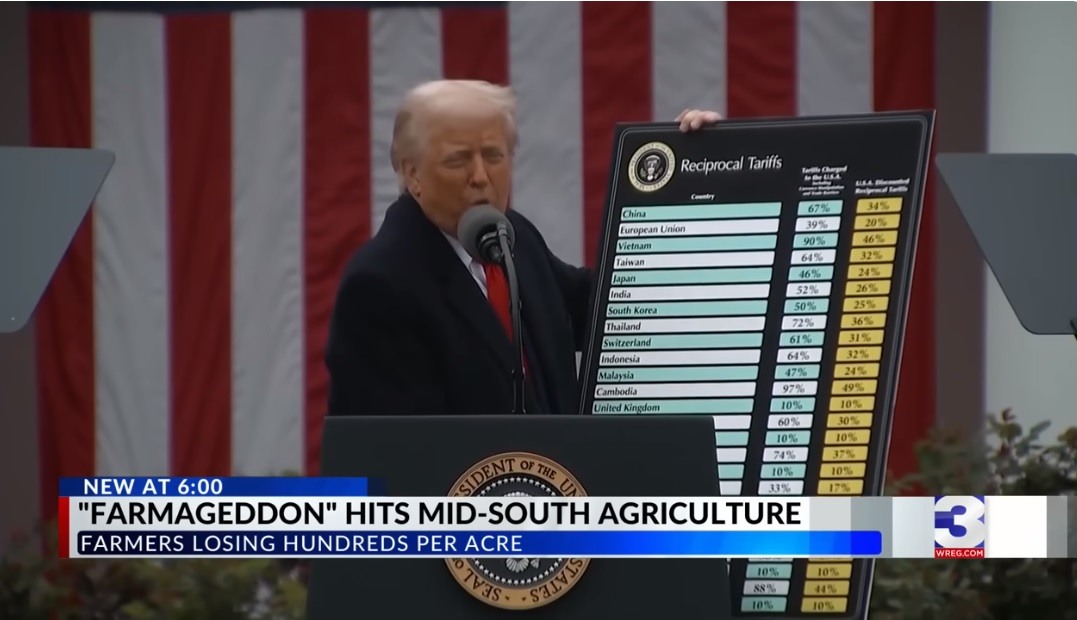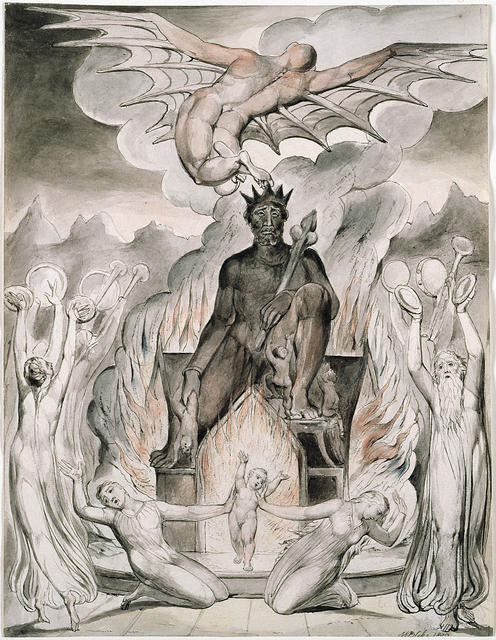by Brian Shilhavy
Editor, Health Impact News
As the U.S. now heads into the Fall harvest season, the impacts of Trump’s tariffs are being more clearly seen, where farmers all across the U.S. are sounding the alarm about the collapse of our agricultural system, with one out of every three farms going out of business in certain parts of the country.
What we are seeing this Fall in the U.S. are the effects of a mass loss of farm labor due to deportations, increased prices on farm equipment and other farm materials that are mostly imported (like parts for John Deere tractors), and of course the loss of the China market, the country where most U.S. farm products have been exported to in past years.
Ohio family farmers describe life under Trump tariffs: ‘We’re in a hell of a mess here.’
“We’re in a hell of a mess here,” said Ohio farmer Chris Gibbs as he worked on his combine at the start of harvest season.
“A severe cash flow mess,” he sighed. “A working capital mess.”
Gibbs, who farms more than 500 acres of corn, soybeans, wheat, and alfalfa hay in Shelby County, along with a 90-head cow-calf operation, described the five-alarm fire raging in the farming community from Trump’s blanket tariffs.
Some growers have called the fallout from his chaotic trade war, and the reciprocal tariffs it provoked, a “farmageddon” that could ruin what made rural America great.
It’s that bad.
The Trump tariffs are shrinking incomes and exploding expenses for farmers, who, thanks to a president they still overwhelmingly support, fear losing their farms.
Many don’t know how much longer they can hang on.
Trump’s punitive tariffs on foreign buyers made their crops less competitive in markets around the world (and drove down prices more) while other senseless tariffs on fertilizer, steel, aluminum, and lumber just sent the cost of doing business through the roof.
The double whammy of Trump tariffs is especially painful for family farms that make up about 87% of all farms in Ohio.
Individual farmers struggle to break even, buy supplies, sell their crops, and build a sustainable future with long-term customers.
But the current tariff dance with Trump keeps them up nights.
Everything a farmer buys “from phosphate and potash to agricultural chemicals, herbicides, machine parts, is up by 50% over the last decade, while our proceeds from the sale of crops is down by 40%,” said fifth-generation Ohio farmer Joe Logan.
The former president of the Ohio Farmers union — a group focused on family farmers — maintained “the industrial agricultural community is chugging right along, raking in billions of dollars” while family farmers are not making any money.
Instead, they’re battling irrational tariffs, rising costs, high interest rates, farm bankruptcies and abiding dread.
How will they move crops without buyers or the major trade deals Trump promised to fix what he broke? (Full article.)
The biggest crop losses to China are American soybeans. Last year China bought $12.6 billion of soybeans, and this year they have bought ZERO, since Trump levied tariffs against them earlier in the year.
Instead, China has turned to Brazil to import soybeans, and after the Trump Administration just gave Argentina a new $20 billion bailout package to “help their economy,” Argentina immediately removed their own tariff to China and sold them several shiploads of soybeans, betraying U.S. farmers.
In Arkansas, one out of every 3 farmers is going out of business. They call the current crisis a “tsunami”.
Here’s a video compilation with farmers speaking out all across the country. Most Americans are probably unaware that this is happening, as it does not make the headline news each day, yet.
Federal Reserve Bank of Chicago President Austan Goolsbee also sounded the alarm on the effects of Trump’s tariffs yesterday at an agricultural conference.
This is from Bloomberg:
Federal Reserve Bank of Chicago President Austan Goolsbee said the most recent round of tariffs may be causing businesses in his district to again pause decision-making in order to see where the levies settle.
“Now, it seems like we’re going into a new wave of tariff announcements,” Goolsbee said Tuesday at an agricultural conference hosted by his bank.
“When I’m out talking to people, it feels like they’re just wary, they’re uncertain and we might be going back into that, everybody-just-put-your-pencils-down kind of a moment, where you just wait until you figure out where it’s going to be,” he added.
President Donald Trump has in recent days announced new tariffs on products including heavy trucks, lumber and kitchen cabinets. Tariffs impact Goolsbee’s reserve bank district — which includes the manufacturing core of Michigan, all of Iowa and parts of other neighboring states — particularly hard, he said.
Trump announced his first round of country-specific tariffs in early April and frequently changed the rates and implementation dates in the months that followed.
The president also expanded tariffs on certain sectors, including some metals and industrial inputs. The uncertainty drove many businesses to pause major investment decisions as they waited to see what the levies would ultimately look like. (Full article.)
As a business owner myself that has been selling products online for over 23 years produced by small-scale family farmers, I can testify to the truth of what this Federal Reserve Bank president is saying, as we are facing many of the same tough decisions heading into this Fall.
Our last container we imported from the Philippines of Virgin Coconut Oil had a 10% tariff added to it, and as we look at our Fall orders, we are now faced with a 19% tariff from the Philippines that just recently went into effect.
The U.S. Supreme Court is hearing an appeal to the legality of Trump’s tariffs which were invoked by an Executive Order based on a suspect “Emergency Order” that had never been applied to tariffs in the past. That hearing is in early November, and we have no idea which way this is going to go.
So we have to figure out if we can afford, and if our customers are willing to pay, that increase as the economy may soon be in a free fall, not just due to tariffs, but the ever increasing AI bubble that could burst any time.
In a survey of companies published last week by MarketWatch, they reported that while costs have gone up for many companies, their consumers are not willing to pay more for their products.
U.S. economy still struggling to adjust to tariffs, S&P finds, and there’s one big danger sign
Excerpt:
Tariffs have raised prices of supplies for most companies, but those companies been unable to fully pass the costs along to customers, who’ve become resistant to paying more.
That’s a big reason inflation hasn’t risen as much as expected because of the tariffs.
The downside is that manufacturers have reported a potentially dangerous increase in inventories, or unsold goods, because of lack of demand. Factory inventories rose to the highest level on record in the S&P survey. (Source.)
For our U.S. produced products, which include our grass-fed and grass-finished beef and pastured poultry raised in western Wisconsin, we are feeling the pressure there as well, as we have to purchase a whole year’s worth of inventory between a very short window that starts now and goes through the middle of November, where the animals are still grazing on grass pasture.
We are currently running a sale on our Galloway Beef grass-fed ground beef from last year’s inventory, and this is the last time our customers will probably ever see us selling some of the highest quality ground beef in the U.S. for only $6.99 lb.
We are looking at options now on selling a whole side of beef, such as a half or quarter cow, in bulk, to help consumers who want to invest in this beef at a lower rate at bulk pricing.
This might be the time for people to invest in a good size chest freezer to provide food security for you and your family, especially if you have access to whole sides of beef from local farmers you trust.
Because if consumers are not willing to support local small-scale family farms, soon the only food choices you may have left are the big box retailers like Walmart and Aldi who use their size to leverage prices lower.
Just don’t expect the same quality as smaller producers, such as the ones we support, or the attention to detail like an operation such as ours takes, as we test all of our food for the presence of dangerous herbicides such as glyphosate.
Then there are the Big Tech giants who are getting into the food industry, many of whom want to produce “food” in the lab, such as Bill Gates.
Amazon.com is probably the biggest threat to the U.S. food system right now, as they can literally sell food below cost, and drive most of their competitors out of business, through their nationwide logistics and delivery systems through ecommerce.
And that seems to be exactly what they are planning. Here are a couple of recent articles revealing their plans.
Amazon’s next stock catalyst isn’t AI — it’s online groceries
Amazon’s push into same-day grocery delivery could help it become the industry leader, surpassing Walmart
Artificial intelligence has been the main catalyst for the “Magnificent Seven” companies this year. Admittedly, that hasn’t done much to help Amazon.com Inc.’s stock — but the company has another growth driver up its sleeve.
Amazon’s e-commerce business is set to benefit massively from its expansion into online grocery delivery, led by its same-day delivery initiative.
Amazon has plans to provide same-day grocery delivery services to more than 4,000 smaller cities and towns in the U.S. by the end of 2025, up from just 1,000 in July of this year. It’s a business move that could significantly boost Amazon’s e-commerce market share and drive up sales per Prime member, Rossington said.
The online grocery market is projected to reach $220 billion by the end of 2025. (Source.)
Amazon launches ‘price-conscious’ grocery brand with most products under $5
Amazon is launching a new private-label grocery brand aimed at “price-conscious” shoppers.
Amazon on Wednesday expanded its private-label grocery lineup with the launch of a new brand aimed at “price-conscious” shoppers, with most products priced under $5.
The brand is called Amazon Grocery and includes more than 1,000 items, ranging from dairy, fresh produce, meat and seafood to snacks and baking essentials, the company said in a release. Amazon said the new offering unites its Happy Belly and Amazon Fresh brands under one label.
“During a time when consumers are particularly price-conscious, Amazon Grocery delivers more than 1,000 quality grocery items across all categories that don’t compromise on quality or taste – from fresh food items to crave-worthy snacks and pantry essentials – all at low, competitive prices that help customers stretch their grocery budgets further,” Jason Buechel, Amazon’s vice president of worldwide grocery, said in a statement. (Source.)
Of course Amazon.com has been promoting biometrics such as face scans and palm scans for the past few years at their grocery stores, and you can be sure that anything and everything you purchase online or in stores via Amazon.com is building an online profile of you and your purchasing habits that more than likely are fed into all the AI models now being developed.
Farmageddon is here, and it’s getting worse. Stop voting for politicians to change things, and start voting with your dollars, supporting local businesses and local farms, or soon you will have no more choices at all outside of the Wall Street and Silicon Valley choices for Big “Food”.
Comment on this article at HealthImpactNews.com.
This article was written by Human Superior Intelligence (HSI)
See Also:
Understand the Times We are Currently Living Through
The Demonic Roots of Christianity: The Christians Jesus Said He Hated
Who are God’s “Chosen People”?
Life in the Spirit versus the Religious Life in the Flesh
KABBALAH: The Anti-Christ Religion of Satan that Controls the World Today
Christian Teaching on Sex and Marriage vs. The Actual Biblical Teaching
Exposing the Christian Zionism Cult
The Bewitching of America with the Evil Eye and the Mark of the Beast
Jesus Christ’s Opposition to the Jewish State: Lessons for Today
Identifying the Luciferian Globalists Implementing the New World Order – Who are the “Jews”?
The Brain Myth: Your Intellect and Thoughts Originate in Your Heart, Not Your Brain
The Seal and Mark of God is Far More Important than the “Mark of the Beast” – Are You Prepared for What’s Coming?
The Satanic Roots to Modern Medicine – The Image of the Beast?
Medicine: Idolatry in the Twenty First Century – 10-Year-Old Article More Relevant Today than the Day it was Written
Having problems receiving our emails? See:
How to Beat Internet Censorship and Create Your Own Newsfeed
We Are Now on Telegram. Video channels at Bitchute, and Odysee.
If our website is seized and shut down, find us on Telegram, as well as Bitchute and Odysee for further instructions about where to find us.
If you use the TOR Onion browser, here are the links and corresponding URLs to use in the TOR browser to find us on the Dark Web: Health Impact News, Vaccine Impact, Medical Kidnap, Created4Health, CoconutOil.com.





















